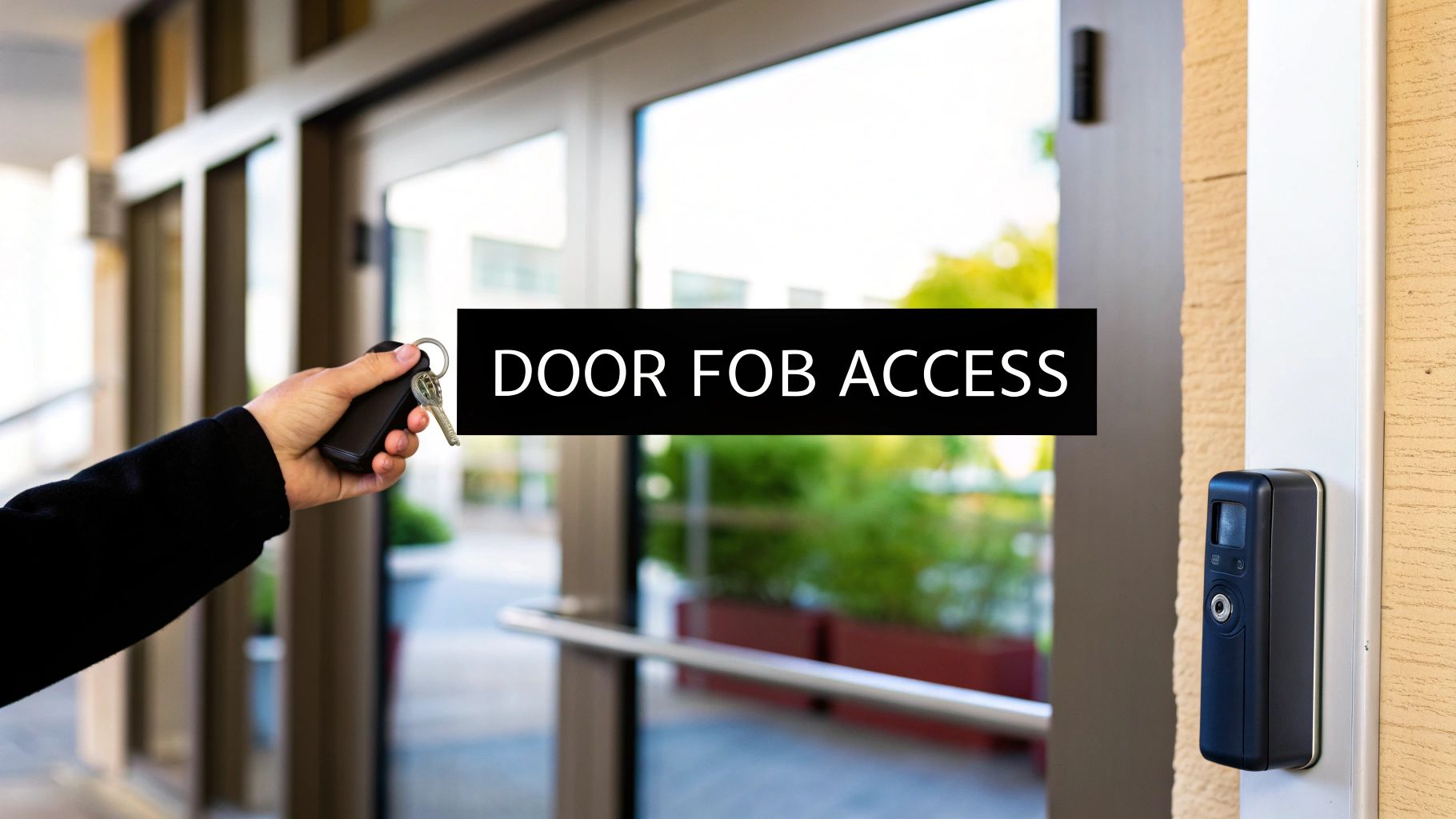Think of door fob entry systems as a modern-day digital handshake, replacing the old, clunky metal key. Instead of fumbling for the right key on a ring, you simply present a small electronic fob to a reader. This one simple action grants instant, authorized access to a building or a specific room, all without any physical contact. It's this straightforward, secure interaction that forms the backbone of modern access control.
How Door Fob Entry Systems Work
So, what’s really happening in that split second when you tap your fob? Imagine your fob holds a secret password, and the reader at the door is the bouncer. When you bring the fob close, you're not just unlocking a mechanical deadbolt; you're triggering a high-speed, secure conversation between several electronic parts. The entire sequence is over in a blink, creating a smooth entry experience that leaves old-fashioned keys in the dust.
This seamless process relies on a few key pieces of hardware working together flawlessly. Each component has a specific job, from carrying your digital credentials to making the final call on whether to grant access. Getting to know their roles is the first step in understanding just how much security and efficiency these systems bring to the table.
The Key Components and Their Roles
The "magic" behind door fob entry systems is actually quite simple when you break it down. It all comes down to four critical elements working as a team.
To make this easier to visualize, here’s a quick rundown of the essential parts and what they do.
| Component | Function | Analogy |
|---|---|---|
| The Key Fob (The Token) | This is your digital key. It's a small device with a microchip inside that holds a one-of-a-kind identifier. | Think of it as a secure ID card that speaks a language only the reader understands. |
| The Reader (The Gatekeeper) | Mounted by the door, this device sends out a constant, low-energy radio field. When a fob gets close, the reader "wakes it up," reads its unique ID, and sends that info to the control panel. | It's the bouncer at the door, checking IDs before letting anyone pass. |
| The Control Panel (The Brain) | This is the central hub of the operation. It takes the ID from the reader and checks it against a database of approved users. Based on that check, it decides to grant or deny access. | It’s the security manager in the back office, verifying credentials and making the final decision. |
| The Electronic Lock (The Muscle) | This isn't your average lock. It’s controlled electronically and waits for the "unlock" command from the control panel. Once it gets the green light, it retracts the bolt to open the door. | This is the physical barrier that only moves when the brain tells it to. |
Each part plays a distinct role, but they all work together to create a secure and automated entry point.
This flow chart gives a great visual of that simple, three-step interaction between your fob, the reader, and the lock.
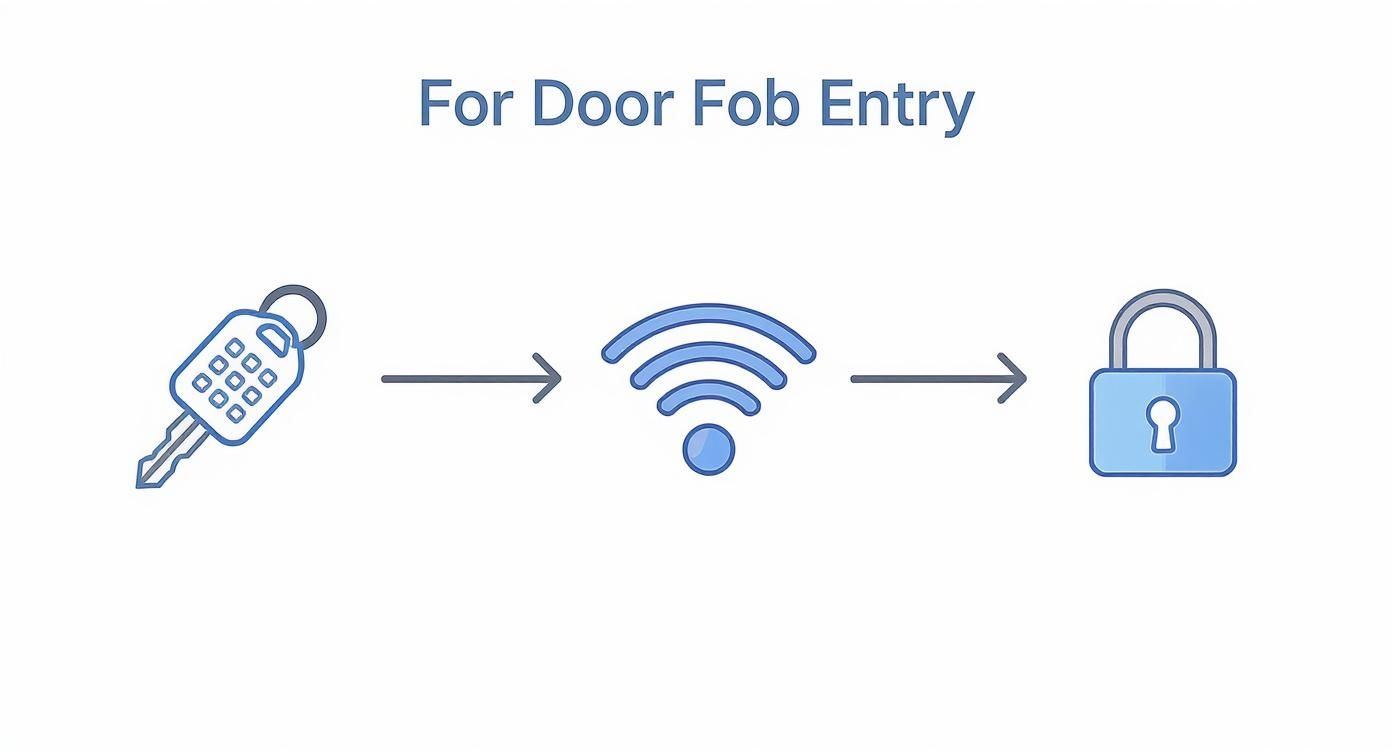
As you can see, the process moves logically from the user's action to the system's reaction, making entry both fast and easy to track. The technology driving this exchange—usually Radio-Frequency Identification (RFID)—ensures the whole process is reliable and secure.
It’s no surprise this technology is catching on. Thanks to its proven reliability and security, the global door entry systems market is expected to hit a value of around USD 10.55 billion in 2025. Projections show it growing at a compound annual rate of 8.5% through 2033. You can read more about this impressive market expansion on datainsightsmarket.com.
Exploring the Technology Behind Key Fob Systems
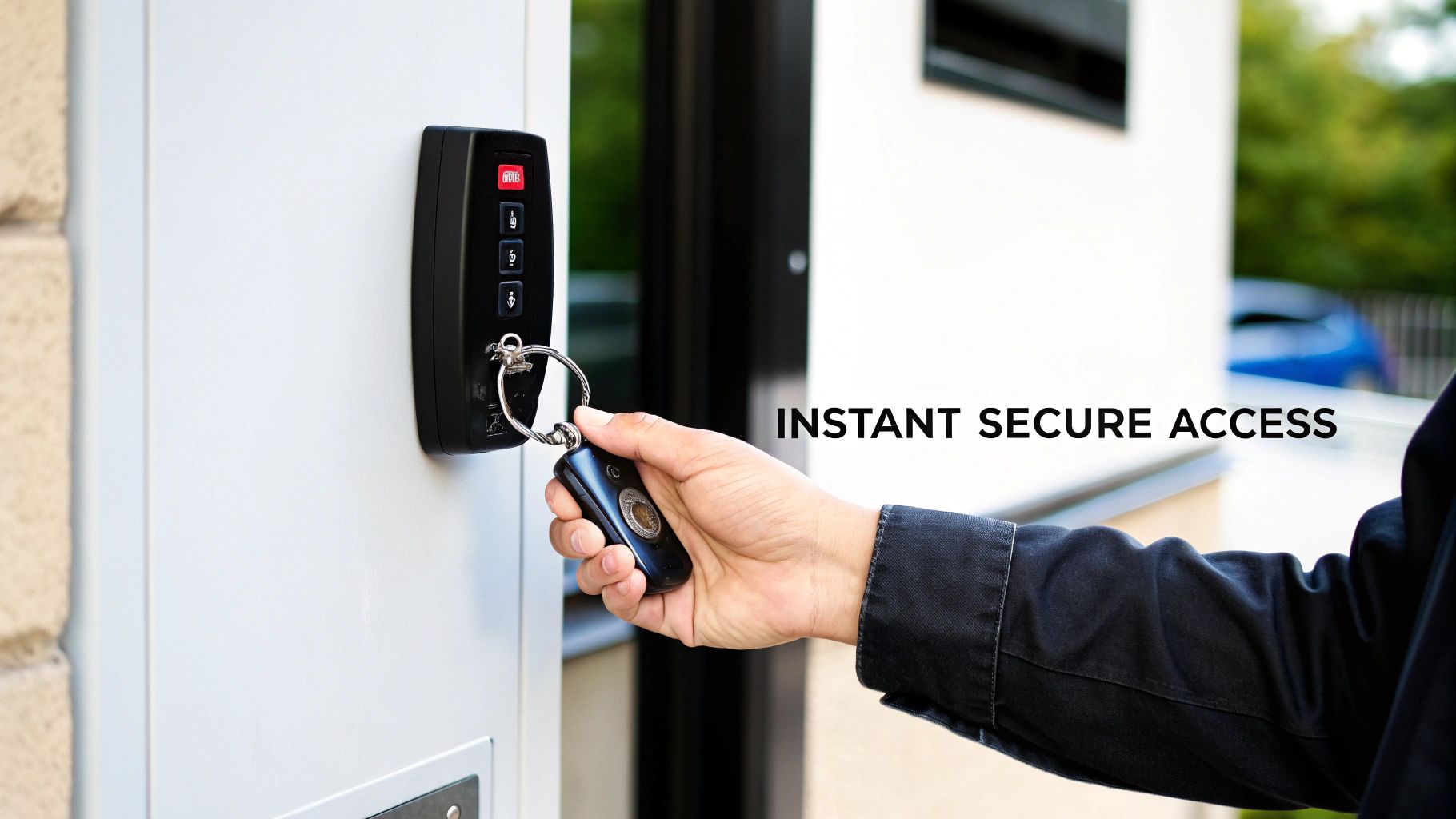
To really get a feel for how door fob entry systems work, you have to look at the individual pieces of tech that bring them to life. It’s a common misconception that all key fobs are the same. In reality, they come in a few different flavors, each built for specific security needs and budgets. Knowing the difference is crucial for picking the right setup.
The most common kind you'll see is the passive RFID fob. These don't have a battery. Instead, they wake up and draw power from the reader itself when held close. This simple design makes them incredibly durable and cheap to produce, which is perfect for places that need a lot of them, like apartment buildings.
On the other hand, you have active RFID fobs. These have a small battery inside, allowing them to broadcast their signal over a much greater distance. They're a great fit for parking garages or gated communities where you want the gate to open as you approach, without having to roll down your window.
Fob Types and Reader Technologies
While the fob is what you carry, the reader on the wall is just as important to the system's performance and security. The reader is the gatekeeper, and its capabilities can range from simple tap-and-go to highly sophisticated.
Here are the main types you'll run into:
- Proximity Readers: These are your bread and butter. Using RFID or NFC, they read a fob that’s a few inches away. They're fast, reliable, and get the job done for most commercial and residential buildings.
- Keypad Readers: Think of this as adding a second password. You tap your fob and enter a PIN. This two-step process is a smart way to lock down more sensitive areas where you need an extra layer of confidence.
- Biometric Scanners: For top-tier security, nothing beats biometrics. These readers confirm a person's identity by scanning a unique physical trait, like a fingerprint or face. This all but eliminates the risk of someone using a lost or stolen credential to get in.
The type of reader you choose really comes down to what—and who—you're trying to protect. These systems are also sophisticated enough to manage more than just standard doors; they can integrate seamlessly with hardware like automatic sliding door systems.
The Power of the Control Software
The fobs and readers are the parts you see and touch, but the real magic happens behind the scenes in the control software. This centralized platform is the brain of the entire operation, giving administrators total command over who can go where and when.
This software is what turns a bunch of individual locks into an intelligent, connected security network. It gives you a complete audit trail, logging who opened which door and at what time—an invaluable tool for both security and day-to-day management.
From a single dashboard, a manager can grant access to a new hire or instantly revoke it for someone who has left the company. They can create custom schedules, like giving a cleaning crew access only between 10 p.m. and 6 a.m.
The software is also where the crucial identity verification takes place. If you’re interested in the technical side of this, our guide on how to https://clouddle.com/blog/how-to-implement-network-security-authentication/ offers a great look into the principles of securing digital credentials. This kind of detailed control and oversight is something you could never achieve with old-fashioned metal keys.
So, why should you actually make the switch to a door fob system?
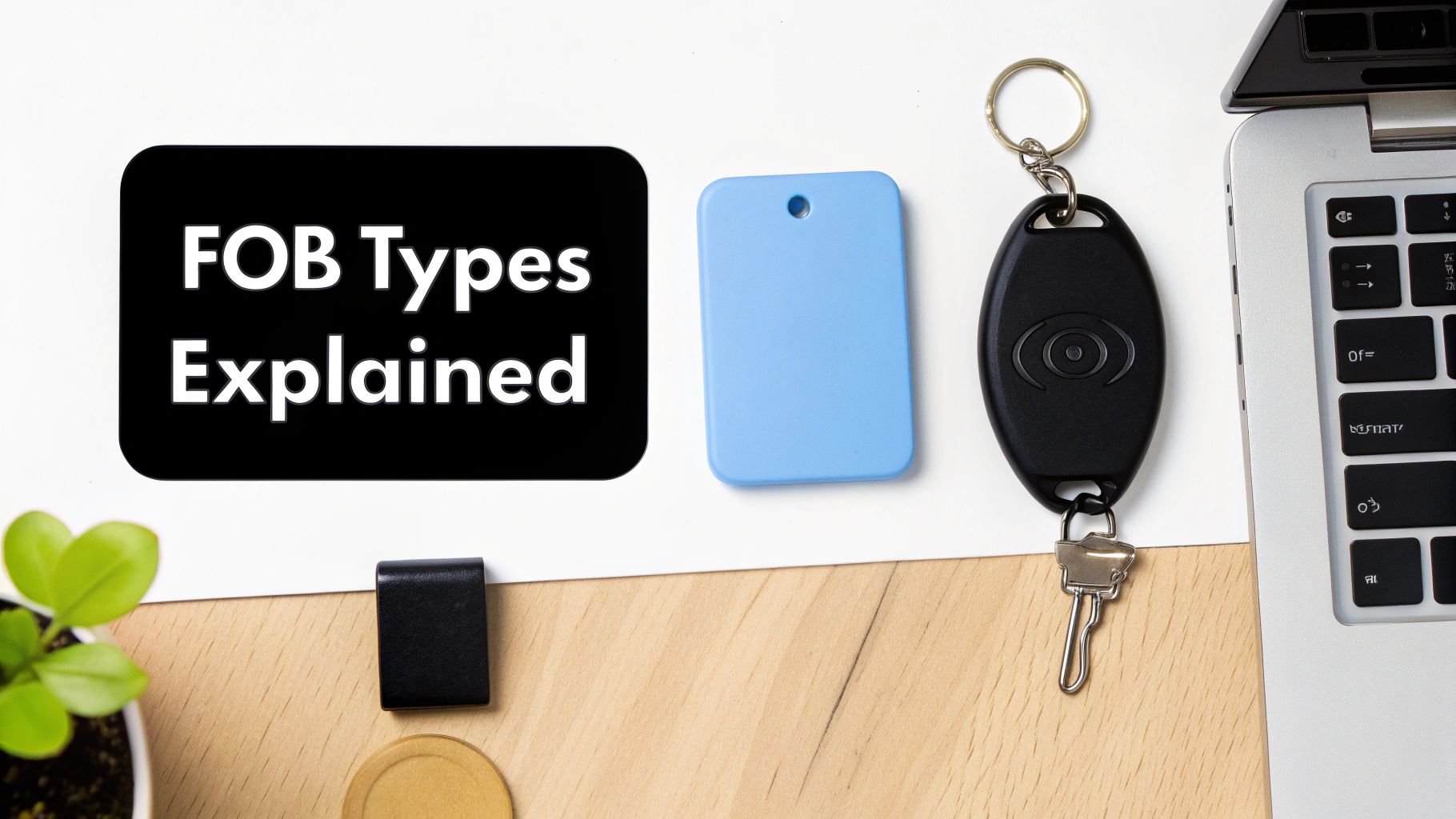
When you get past the technical specs, the real question for any property manager or business owner is pretty straightforward: what’s in it for me? The answer boils down to two huge advantages that old-school keys just can't compete with: seriously better security and much smoother operational control. Upgrading to a door fob entry system isn’t just about changing locks; it’s about fundamentally changing how you manage who comes and goes.
We’ve all dealt with the classic headache of a lost key. With a physical key, that one little mistake can kick off a costly, disruptive process of re-keying multiple locks just to feel secure again. In the meantime, you’re left with a security gap and a logistical mess.
A fob system makes that entire problem disappear.
Think about it: when a key fob is lost or an employee moves on, you can revoke their access from a central dashboard in seconds. No locksmith calls, no cutting new keys, and zero lingering security worries. That immediate peace of mind is priceless.
This ability to manage credentials on the fly is a massive security upgrade, and it saves a ton of time and money in the process.
Gaining Real Operational Control and Insight
The perks of a door fob entry system go way beyond just handling lost fobs. These systems give you a level of operational intelligence that’s simply impossible with a traditional lock and key. Every single time a fob is used, the system logs it, creating a detailed digital record.
This audit trail is an absolute game-changer for anyone managing a property. It provides undeniable, time-stamped proof of who entered a specific area and when. This kind of data is incredibly useful for:
- Security Investigations: If an incident occurs, you can instantly see who was in the area.
- Tenant Accountability: Settle disputes in apartment buildings about who was using the gym or laundry room.
- Vendor Management: Confirm that cleaning crews or maintenance staff are sticking to their schedules.
For example, an office manager can finally lock down the server room, giving access only to the IT team and keeping a perfect log of every entry. In a multi-family building, a property manager can manage tenant turnover without ever swapping a physical key—they just activate a new fob and deactivate the old one remotely.
This level of precise control transforms access management from a constant chore into a simple, efficient part of your daily operations.
Door Fob Applications in Your Industry
The real magic of a door fob system isn't just the technology itself—it's how adaptable it is. The core components are always the same, but you can tailor their application to solve the specific headaches of your industry. This isn't a cookie-cutter solution; think of it as a flexible security framework you can shape to fit your exact needs, whether you're managing a high-rise apartment building or a corporate campus.
Let's look at how these systems play out in the real world. You'll see that different industries lean on different features to protect their people and property, smooth out daily operations, and generally make life easier for everyone involved.
Securing Multi-Family Residential Properties
For anyone managing an apartment building or condo complex, door fob systems are an absolute game-changer. They provide layers of security that begin right at the main entrance and extend to every shared space, creating a safe, controlled environment that's surprisingly easy to manage.
Here’s where they really shine:
- Controlling Main Entrances: The most basic but crucial function. You ensure only current residents and staff can get in the front door, stopping unauthorized traffic cold.
- Managing Common Areas: Keep your amenities like pools, gyms, and laundry rooms exclusive to residents. You can even set schedules to automatically lock them down after hours.
- Simplifying Tenant Turnover: This is a huge time-saver. When a tenant moves out, you just deactivate their fob. No more calling a locksmith to rekey the locks. The new tenant gets an activated fob, and you're done.
This kind of granular control has become a must-have for modern property management. To get a much deeper look at this, check out our guide on improving access control for apartments, which is packed with strategies for boosting security and keeping tenants happy.
Streamlining Commercial Office Access
In an office, security is less about keeping everyone out and more about letting the right people in. Door fob systems are perfect for this, allowing businesses to create detailed, tiered access levels that mirror the company's org chart and security policies.
A fob system acts like an invisible organizational chart for your physical space. It ensures that employees can only access the areas they need for their job, protecting sensitive information and high-value equipment without creating friction.
For instance, you can program fobs to give everyone access to common areas like the kitchen and lobby, but restrict sensitive zones—like server rooms, executive offices, or the finance department—to only a handful of authorized personnel. Better yet, the data from every swipe can be integrated with time and attendance software, helping to automate payroll and HR functions. Suddenly, your security system is also a powerful operational tool.
While offices and large enterprises have historically been the biggest users of these systems, other sectors are quickly realizing the benefits. According to recent research, the healthcare and life sciences industries are poised for major growth, driven by a need for tight hygiene controls and managing the flow of patients and staff. You can find more details about this access control market trend on precedenceresearch.com.
Enhancing Safety in Senior Living Communities
In senior living facilities, you're always balancing safety with convenience. Door fob systems hit that sweet spot perfectly. They create a secure environment that’s still simple for residents, their families, and staff to get around. For residents who might struggle with traditional keys due to limited dexterity, a simple fob is a welcome relief.
You can give staff members master access while programming fobs for family members with specific permissions, like granting entry only during visiting hours. This not only enhances resident safety but also creates a detailed log of every person who enters the community, giving everyone—from residents to their loved ones—invaluable peace of mind.
To better visualize how these features serve different needs, let's compare some key applications side-by-side.
Door Fob System Features by Industry
| Industry | Key Feature | Primary Benefit |
|---|---|---|
| Multi-Family Residential | Tenant Turnover Management | Eliminates the cost and hassle of rekeying locks, simplifies onboarding. |
| Commercial Offices | Tiered Access Levels | Protects sensitive areas (e.g., server rooms) by restricting access. |
| Senior Living | Visitor Management | Custom permissions for family and caregivers enhance resident safety. |
| Hospitality (Hotels) | Temporary Credentials | Guest fobs expire automatically at checkout, boosting room security. |
| Healthcare | Audit Trails | Detailed logs help meet HIPAA compliance for restricted medical areas. |
As you can see, the core technology is the same, but the focus shifts dramatically based on the environment's priorities—whether it's managing tenants, protecting data, or ensuring the safety of vulnerable residents.
How to Plan and Implement Your New System
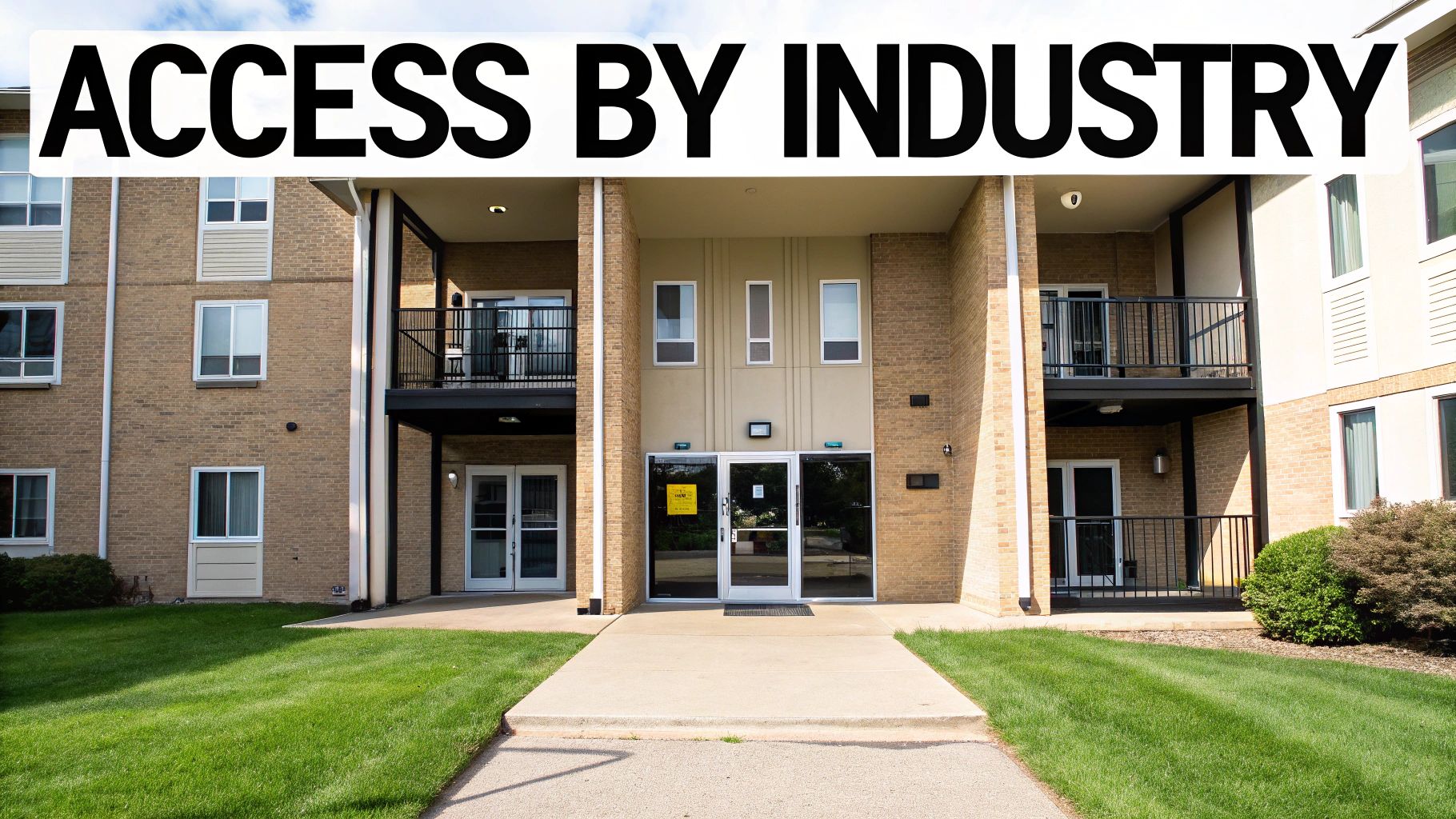
Deciding to upgrade your security is a big move. To make sure your switch to a door fob entry system goes smoothly, it all starts with solid planning. Before you even think about specific brands or hardware, your first step should always be a thorough site assessment.
This isn't just about walking around and counting doors. You need to really dig into how people move through your building. Where are your most vulnerable spots? Which areas absolutely must be locked down, and which are lower risk? A server room, for instance, needs much tighter control than the main lobby. Mapping this out helps you design a system that’s both effective and cost-efficient.
Defining Your System Requirements
With a clear picture of your property's security landscape, you can start drilling down into the specifics. This is where you turn your big-picture security goals into a concrete checklist of features.
Here are a few questions to get you started:
- How many people need access? This will tell you the scale of the system and how many fobs you’ll need right out of the gate.
- Do you need different permission levels? Almost certainly, yes. You'll likely need to create access groups for regular staff, management, vendors, and maybe even cleaning crews.
- What other systems does it need to talk to? Think about tying your new fob system into existing security cameras, alarm systems, or even your building management software for a single, unified command center.
Remember, a strong data network is the central nervous system for any modern access control system. This highlights the importance of data network installation, as it’s what allows the readers, locks, and central server to communicate reliably.
Choosing a Vendor and Managing Installation
Picking the right hardware is only half the battle; choosing the right installation partner is just as critical. You want a vendor who has a proven track record in your specific industry, whether that's hospitality, commercial real estate, or senior living.
A great installer does more than just run wires and mount readers. They’ll work with you to configure the software to match your unique operational rules and access policies. If you need more guidance on what to look for, our guide on commercial security systems installation breaks down how to find and vet the right professionals. You can find it right here: https://clouddle.com/blog/commercial-security-systems-installation/
The trend toward keyless entry is undeniable. The global market for these systems was valued at USD 3.38 billion in 2024 and is expected to climb to nearly USD 8.19 billion by 2032. This rapid growth shows just how many businesses are moving away from traditional keys.
Finally, don't overlook the last—and most critical—step: user training. A state-of-the-art system is useless if no one knows how to use it properly.
Make sure your staff, tenants, or residents feel comfortable with their new fobs. Show them how it works, what to do if a fob is lost, and who to contact for help. Clear communication and simple instructions are the key to getting everyone on board and making the transition a success.
Got Questions About Door Fob Systems? We’ve Got Answers.
Jumping into a new security technology always comes with a few questions, and that’s a good thing. Upgrading your property to a door fob entry system is a big decision, and it’s smart to get all the facts first. Over the years, we've found that property managers tend to ask the same handful of practical questions.
Let's walk through those common concerns. We'll clear up everything from what to do about lost fobs to how these systems play with your other tech, so you can feel confident about your next steps.
What Happens if a Fob Is Lost or Stolen?
This is easily the most common question we get, and for good reason. But the answer is precisely where fob systems shine compared to old-school keys. When a metal key goes missing, you’re stuck with a tough choice: either rekey the lock (which costs a fortune and takes time) or just hope for the best.
With a key fob system, the fix is instant and digital. You just log into the management software and kill the missing fob’s access rights.
In less than a minute, that lost fob is nothing more than a useless piece of plastic. The security risk is gone—no locksmith, no stress, no wasted money. Then, you can assign a new fob to the user in a few clicks. It’s that simple.
How Vulnerable Are Fob Systems to Hacking?
It's wise to be skeptical about the security of any connected device. While no system is Fort Knox, modern door fob entry systems are built with serious encryption protecting the signal between the fob and the reader. This makes them worlds more secure than the first-generation proximity cards that could be easily cloned.
To keep your system as secure as possible, you really just need to follow a few common-sense rules:
- Stick with Reputable Brands: Partner with manufacturers who have a proven track record in security and consistently release firmware updates to patch any weaknesses.
- Use Encrypted Fobs: Always choose modern, encrypted fobs. They're designed specifically to stop someone from making a digital copy.
- Follow Smart Security Habits: Use strong, unique passwords for the management software and make it a habit to glance at the access logs to spot anything out of the ordinary.
Following these steps makes your property a much tougher target than any building relying on a simple lock and key.
Can Fob Systems Integrate with Other Technology?
Absolutely. In fact, that's one of their biggest selling points. A good access control system is designed to be the backbone of your building's entire security setup, and it can talk to all sorts of other smart building tech.
Here are a few popular integrations:
- Video Surveillance: You can link your fob system to your security cameras. When someone uses a fob to open a door, the system can automatically trigger the camera to record, giving you a visual record of every single entry.
- Alarm Systems: Configure the system to arm or disarm your building's alarm when an authorized person badges in or out. This really simplifies opening and closing routines for your staff.
- Visitor Management Platforms: Connect to a visitor check-in system to automatically issue temporary access to guests or contractors, which conveniently expires when their visit is over.
When you start connecting these systems, you create a single, smart security network that gives you a level of control and insight you just can't get otherwise.
What Are the Ongoing Costs and Maintenance?
The upfront cost includes the hardware—readers, locks, and control panels—plus the installation. But once the system is up and running, the ongoing costs are surprisingly low. The biggest long-term savings come from not having to call a locksmith every time a key is lost.
Day-to-day maintenance is pretty minimal. You'll have occasional software updates to keep things secure and you might do a quick check on the hardware now and then. The fobs themselves are built to last, and because they're reprogrammable, you won't be buying new ones constantly unless you're adding more people to the building. Many find that the money saved on rekeying alone pays for the initial investment over time.
Ready to modernize your property's access control? The experts at Clouddle Inc specialize in designing and installing integrated security solutions that enhance safety and operational efficiency. Learn more about our managed technology services and schedule a consultation today.


